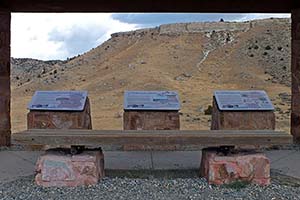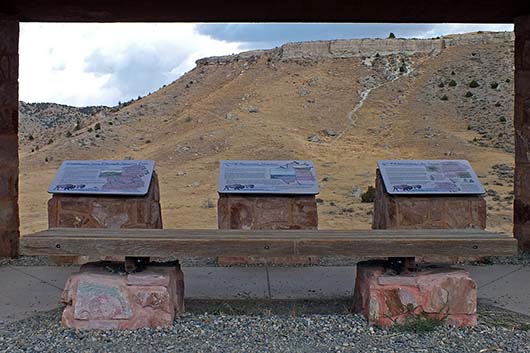
The view from the top of the jump was stunning, but it was the history and power of the place that really struck him. The jump tells the story of how Native American nations used the land to harvest bison. It is a story about survival and community, and a story that changed Goold’s understanding.
“Like most non-natives, I was ignorant of the knowledge and wisdom indigenous peoples used to stampede bison off a site like that,” Goold, now coordinator of the Friends of the Madison Buffalo Jump, said recently. “It contradicts a lot of assumptions and myths that we are taught in our history classes. Once you understand how a communal bison jump was used by tribal nations, it turns on its head what is civilized and what is sophisticated.”
Madison Buffalo Jump State Park, located a short distance from the Madison River on Buffalo Jump Road, was authorized by the Montana Legislature in 1965 and formally established in 1967. The park features a variety of hiking trails that lead around the jump, and a series of interpretive panels that tell the story of how Native Americans used the site.
Park Manager Dave Andrus said Madison Buffalo Jump was used for thousands of years by nearly all the Native American nations of Montana. The introduction of the horse brought with it mounted bison hunts and spelled the end for the buffalo jump, but archaeological evidence suggests the site was used as recently as 200 years ago.
“We think the Shoshone used the jump and the Crow and Blackfeet,” Andrus said. “The Salish used the jump as well. The rivers were always major corridors so groups of people moved through. This was an area many people passed through, but they preferred to winter somewhere else and traveled to the plains to hunt buffalo, even more than this area.”
Andrus said evidence of the site’s significance surrounds visitors. A recent archaeological study conducted by the University of Montana unearthed numerous artifacts at the site.
“At the top of the buffalo trail, you come up on some old teepee rings,” Andrus said. “If you know what you are looking for you can see the rock cairns they would use to direct the buffalo to the edge and that they would hide behind.”
Andrus said Madison Buffalo Jump is unique in that there are many bison bones still buried at the site. Once bison were stampeded off the cliff, the community would spend several days or weeks processing the animals. Those bone piles presented a source of fertilizer used by Montana’s early settlers, but Madison Buffalo Jump was not mined.
The Antiquities Act of 1906 protects the artifacts at Madison Buffalo Jump. It is illegal to remove relics or disturb the site. Still, collections of arrowheads, bones and other relics found at the jump are on display at the Museum of the Rockies, the Gallatin County Courthouse and the Headwaters Heritage Museum in Three Forks.
While the cultural, archaeological and recreational importance of Madison Buffalo Jump State Park is certain, its future as a state park is not.
A 2008 audit by the Montana Department of Natural Resources and Conservation found it was not collecting lease payments on the site from Montana Fish, Wildlife & Parks, which maintains the park. DNRC required FWP to start making lease payments on the property in 2012.
FWP briefly considered forfeiting management of the park due to budget constraints, but an outpouring of support for the park during a public comment period convinced the department to maintain its management role.
Goold said Friends of the Madison Buffalo Jump, which was formed in response to the action, is contesting DNRC’s authority to collect lease payments on the property. The Friends assert DNRC is ignoring the 1965 Montana law that facilitated the donation of the land to the state for the sole purpose of the property being managed as a state park within the state parks system.
Goold said transfer of the park to DNRC authority could result in the property being sold to the highest bidder for the development of luxury homes, or leased for grazing purposes. The Friends are asking DNRC and FWP to reach an agreement that would free FWP from lease payments and formalize FWP’s responsibility to preserve and protect the site for posterity.
“Everybody’s shared interest is in seeing this preserved as a state park,” Goold said. “It is a special place to a broad cross section of the public for different reasons. It is a cultural, scientific, archaeological and recreational treasure. Whether you are native or non-native, it has significance on a national level.”
___
Information from: Bozeman Daily Chronicle, http://www.bozemandailychronicle.com
Copyright 2014 Associated Press. All rights reserved. This material may not be published, broadcast, rewritten, or redistributed.
AP-WF-10-02-14 2253GMT
ADDITIONAL IMAGE OF NOTE


